train
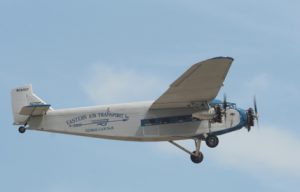 In the early history of airplanes, they were used for things like mail. No one had really considered other uses, or if they did, the idea was far in the future in the minds of most people. Nevertheless, there was one man…William Bushnell Stout, who was an aeronautical engineer. William had previously designed several aircraft using principles similar to, and originally devised by Professor Hugo Junkers, the noted German all-metal aircraft design pioneer. Junkers was one of the mainstays of the German aircraft industry in the years between World War I and World War II. In particular his multi-engined all-metal passenger and freight planes helped establish airlines in Germany as well as all over the world. Stout designed planes using the same principles as Junkers had, but they were pretty much on paper. Then in the early 1920s, Ford Motor Company Henry Ford, along with a group of 19 other investors including his son Edsel, invested in the Stout Metal Airplane Company. Stout, a bold and imaginative salesman, sent a mimeographed form letter to leading manufacturers, asking for $1,000 and telling them, “For your one thousand dollars you will get one definite promise: You will never get your money back.” Stout raised $20,000, including $1,000 each from Edsel and Henry Ford. It’s hard for me to imagine that he would get even one investor, but I guess they figured he was, if nothing else, truthful.
In the early history of airplanes, they were used for things like mail. No one had really considered other uses, or if they did, the idea was far in the future in the minds of most people. Nevertheless, there was one man…William Bushnell Stout, who was an aeronautical engineer. William had previously designed several aircraft using principles similar to, and originally devised by Professor Hugo Junkers, the noted German all-metal aircraft design pioneer. Junkers was one of the mainstays of the German aircraft industry in the years between World War I and World War II. In particular his multi-engined all-metal passenger and freight planes helped establish airlines in Germany as well as all over the world. Stout designed planes using the same principles as Junkers had, but they were pretty much on paper. Then in the early 1920s, Ford Motor Company Henry Ford, along with a group of 19 other investors including his son Edsel, invested in the Stout Metal Airplane Company. Stout, a bold and imaginative salesman, sent a mimeographed form letter to leading manufacturers, asking for $1,000 and telling them, “For your one thousand dollars you will get one definite promise: You will never get your money back.” Stout raised $20,000, including $1,000 each from Edsel and Henry Ford. It’s hard for me to imagine that he would get even one investor, but I guess they figured he was, if nothing else, truthful.
The Ford Motor Company produced the Ford Trimotor in 1927. It was one of the first all-metal airplanes. It was often called the “Tin Goose” or “Flying Washboard.” It was the first plane that was designed to carry passengers rather than mail. Now, I don’t know about you, but the idea of flying in something called the Tin Goose or Flying Washboard, would not bring with it a feeling of confidence in the machine that was suppose to get me to my destination. I have to wonder how many people they were able to get to fly in the plane in those years. The plane was designed to carry twelve people and had three engines. The three engines allowed the plane to fly higher and faster than other airplanes or that time period. The plane could reach speeds of 130 miles per hour. The Ford 4-AT-15 Trimotor monoplane, which was piloted by Berndt Balehen, was first used in the first flight over the South Pole in November if 1929.
The interior of the plane was much like the interior of a passenger car on a train. Like most of the seats of any moving vehicle, design as come a long way, both in comfort and in safety, but at that time, it was state of the art. Now planes like this are a novelty item, that people go to see, because it is something they have never seen before, and may never see again. These days, the Tin Goose flies around the country being that novelty item. Recently it came to Casper, and I really wish I had been able to go see it and take a ride…maybe next time. It would be cool to fly in a Flying Washboard or a Tin Goose.
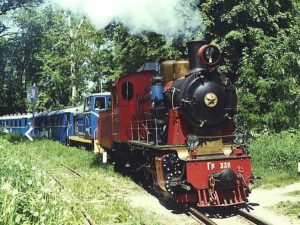 If I tell you that there exists in this world, a children’s railway, would you think of the Orphan Train, bringing children out West for adoption into families there? Or would you think of some kind of forced child labor on the railways? Either way…you would be wrong. The Children’s Railway was started in Soviet Russia in 1932. The concept is a unique one. The idea was to teach teenaged children to build and run a railroad as a way of learning the railroad trade. It was an extracurricular activity that was voluntary. Things like that aren’t offered in this country…at least not that I’m aware of. Nevertheless, I think my grandfather, Allen Luther Spencer might have enjoyed that, had it been offered in his time. I also think that my cousin by marriage, James Forseen, might have loved that since he has always loved trains, and managed to land a job with the railroad. He loved them so much that he had to have one in the wedding photos when he
If I tell you that there exists in this world, a children’s railway, would you think of the Orphan Train, bringing children out West for adoption into families there? Or would you think of some kind of forced child labor on the railways? Either way…you would be wrong. The Children’s Railway was started in Soviet Russia in 1932. The concept is a unique one. The idea was to teach teenaged children to build and run a railroad as a way of learning the railroad trade. It was an extracurricular activity that was voluntary. Things like that aren’t offered in this country…at least not that I’m aware of. Nevertheless, I think my grandfather, Allen Luther Spencer might have enjoyed that, had it been offered in his time. I also think that my cousin by marriage, James Forseen, might have loved that since he has always loved trains, and managed to land a job with the railroad. He loved them so much that he had to have one in the wedding photos when he 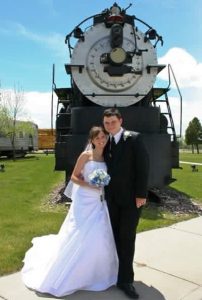 married my cousin Dani Byer Forseen. Just imagine James, if you could have worked on a railroad in high school!!
married my cousin Dani Byer Forseen. Just imagine James, if you could have worked on a railroad in high school!!
As I said, the children’s railway was a phenomenon that originated in the USSR. The first Children’s Railway opened in Gorky Park in Moscow, on July 24, 1932. It was a greatly developed activity in Soviet times. By the time the USSR broke up, there were 52 children’s railways in existence in that country. Many children’s railways are still functioning in post-Soviet states and in Eastern Europe, so obviously this is an activity that has taken off…and imagine the kids who would stay out of trouble if they fell in love with railroad work. I can envision the kids having such a great time running the railroad that they would never have the time or the inclination to get into trouble or into gangs. Their imagination would be too busy.
The children’s railway has come so far that many of them exhibit railway technology not seen anymore on the  main lines and they can be seen as heritage railways. Even though a few exceptions exist, most of the children’s railways that were built in the communist block have a track gauge of at least 600 mm (1 feet 11 5/8 inches) and can carry full size narrow gauge rolling stock. Of course, for the sake of safety and training purposes, the children’s railways are all run under the supervision of adult railroad workers, but what better way for things to be done. The children’s railways in existence these days are mostly for the purpose of tourism, but I suppose that if necessary, they could be used for other reasons. Whatever their purpose is today, I think the Children’s Railways sound like a very cool idea.
main lines and they can be seen as heritage railways. Even though a few exceptions exist, most of the children’s railways that were built in the communist block have a track gauge of at least 600 mm (1 feet 11 5/8 inches) and can carry full size narrow gauge rolling stock. Of course, for the sake of safety and training purposes, the children’s railways are all run under the supervision of adult railroad workers, but what better way for things to be done. The children’s railways in existence these days are mostly for the purpose of tourism, but I suppose that if necessary, they could be used for other reasons. Whatever their purpose is today, I think the Children’s Railways sound like a very cool idea.
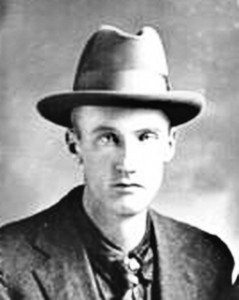 My husband, Bob’s great grandfather, Chester Leary worked for the railroad for most of his adult life. As a railroad worker, I’m sure he saw his share of close calls and accidents over the many years he worked there. Many railroad accidents make the national news, of course, but it’s possible they didn’t so often many years ago, because communication wasn’t quite as good. Nevertheless, if you lived near the train wreck, I’m sure you heard about it. I’m also sure that railroad yard accidents were a somewhat common occurrence. There is so much that goes on in a railroad yard, that sometimes things get missed, and an accident happens, but in my research for this story, I couldn’t find the accident in question here, or in fact, much information about very many railroad yard accidents at all. Maybe they just weren’t a news worthy event, unless someone was killed in the accident.
My husband, Bob’s great grandfather, Chester Leary worked for the railroad for most of his adult life. As a railroad worker, I’m sure he saw his share of close calls and accidents over the many years he worked there. Many railroad accidents make the national news, of course, but it’s possible they didn’t so often many years ago, because communication wasn’t quite as good. Nevertheless, if you lived near the train wreck, I’m sure you heard about it. I’m also sure that railroad yard accidents were a somewhat common occurrence. There is so much that goes on in a railroad yard, that sometimes things get missed, and an accident happens, but in my research for this story, I couldn’t find the accident in question here, or in fact, much information about very many railroad yard accidents at all. Maybe they just weren’t a news worthy event, unless someone was killed in the accident.
In fact, I wouldn’t have known about this train wreck at all, except that Bob’s cousin, Joe Brown sent me the picture of the wreck, with Chester Leary in the picture. The picture had the date of the accident listed on the picture, so I know that the date is correct…May 2, 1919. Nevertheless, when I looked for information on that train wreck in Forsyth, Montana in the railroad yard, I found absolutely nothing. To me that is such an odd thing. My curious mind wants to know more about how this accident happened. Was someone not paying attention to the trains coming in and out of the yard? Was anyone hurt? When did electronic tracking of the trains come into being, and would that have made a difference, since it all happened in the yard?
![Train Wreck at Forsyth, MT]pm yard May 2, 1919 Chester Leary](https://carynschulenberg.com/wp-content/uploads/2016/01/Train-Wreck-at-Forsyth-MT-yard-May-2-1919-Chester-Leary-300x198.jpg) Unfortunately, Bob’s great grandfather is no longer with us, and in fact he passed away in 1950, before either of us were born, so we couldn’t have possibly asked such a question, and wouldn’t have know to had we been born earlier. I’m sure his grandmother, Vina Hein knew what happened, because she was probably told all about it by her dad, Chester Leary. I don’t know if her dad was involved, or not, but I’m sure that would have been a story told around the dinner table that night. I really wish I could have had the opportunity to ask Bob’s great grandfather or my grandfather about all of their railroad experiences, because I have to think that it would have been very interesting to hear about it all. Especially about when things went very wrong.
Unfortunately, Bob’s great grandfather is no longer with us, and in fact he passed away in 1950, before either of us were born, so we couldn’t have possibly asked such a question, and wouldn’t have know to had we been born earlier. I’m sure his grandmother, Vina Hein knew what happened, because she was probably told all about it by her dad, Chester Leary. I don’t know if her dad was involved, or not, but I’m sure that would have been a story told around the dinner table that night. I really wish I could have had the opportunity to ask Bob’s great grandfather or my grandfather about all of their railroad experiences, because I have to think that it would have been very interesting to hear about it all. Especially about when things went very wrong.
 These days, when a new president makes the move from their current home to the White House, it is a huge production. Very little of the packing is actually done by the first family. Things were much different in 1861, when President Abraham Lincoln was moving to Washington DC. When Abraham Lincoln moved to Washington DC, he packed his family’s belongings himself. His wife Mary was in Saint Louis on a shopping trip, so she would join him later in Indiana. It was on this day, February 11, 1861 that Abraham Lincoln boarded a two car private train…probably the only special thing about this transition. After an emotional speech to his fellow Springfield, Illinois citizens, Abraham Lincoln moved to Washington DC. The day was cold and rainy…much like the mood as Lincoln left his friends. He spoke to a crowd before departing: “Here I have lived a quarter of a century, and have passed from a young man to an old man. Here my children have been born, and one is buried. I now leave, not knowing when, or whether ever, I may return, with a task before me greater than that which rested upon Washington. Without the assistance of that Divine Being…I cannot
These days, when a new president makes the move from their current home to the White House, it is a huge production. Very little of the packing is actually done by the first family. Things were much different in 1861, when President Abraham Lincoln was moving to Washington DC. When Abraham Lincoln moved to Washington DC, he packed his family’s belongings himself. His wife Mary was in Saint Louis on a shopping trip, so she would join him later in Indiana. It was on this day, February 11, 1861 that Abraham Lincoln boarded a two car private train…probably the only special thing about this transition. After an emotional speech to his fellow Springfield, Illinois citizens, Abraham Lincoln moved to Washington DC. The day was cold and rainy…much like the mood as Lincoln left his friends. He spoke to a crowd before departing: “Here I have lived a quarter of a century, and have passed from a young man to an old man. Here my children have been born, and one is buried. I now leave, not knowing when, or whether ever, I may return, with a task before me greater than that which rested upon Washington. Without the assistance of that Divine Being…I cannot 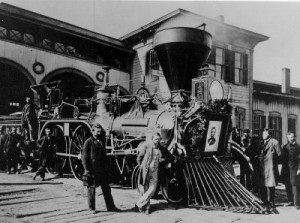 succeed. With that assistance, I cannot fail. To His care commending you, as I hope in your prayers you will commend me, I bid you an affectionate farewell.” One of the people who attended the speech, said that the president-elect’s “breast heaved with emotion and he could scarcely command his feelings.”
succeed. With that assistance, I cannot fail. To His care commending you, as I hope in your prayers you will commend me, I bid you an affectionate farewell.” One of the people who attended the speech, said that the president-elect’s “breast heaved with emotion and he could scarcely command his feelings.”
It’s hard to say if Lincoln had an inkling that he was not just saying “goodbye for now” to the citizens of Springfield, Illinois, or not, but there is no doubt that he knew that his presidency was going to be difficult…to say the least. Since his election, seven southern states has seceded from the Union. The nation was in the middle of a national crisis. President Lincoln knew that the nation was quite likely heading for a civil war. In short order, he was proven to be correct, when our nation embarked on one of the most bitter wars it ever fought…waged against its own people, over slavery.
When Lincoln said that it was possible that he would never return to Springfield, he was ironically very correct. 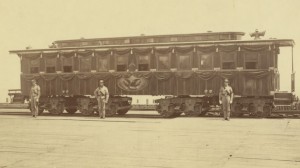 While he returned in body, he did not return in life…as we all know, because he was shot by John Wilkes Booth on April 14, 1865, and died at 7:22am the morning of April 15, 1865. Booth opposed Lincoln’s freeing of the slaves, and maybe felt like killing him would somehow change that. Of course, it did not. After his passing, Lincoln’s body made a two week train trip back to Springfield, Illinois for burial, taking a route that would allow the people to pay tribute along the way. Memorial services were held at different towns when the train passed through them. It was the only time he rode in the new private train car that had been built just for him.
While he returned in body, he did not return in life…as we all know, because he was shot by John Wilkes Booth on April 14, 1865, and died at 7:22am the morning of April 15, 1865. Booth opposed Lincoln’s freeing of the slaves, and maybe felt like killing him would somehow change that. Of course, it did not. After his passing, Lincoln’s body made a two week train trip back to Springfield, Illinois for burial, taking a route that would allow the people to pay tribute along the way. Memorial services were held at different towns when the train passed through them. It was the only time he rode in the new private train car that had been built just for him.
 People always seem to be in a hurry. We encounter cars that fly past us trying to get to their destination on time, when they really didn’t allow enough time for the trip. We are all guilty of running late, and even of speeding to make it on time, and as we all know, sometimes our habit of running late and being in such a hurry, can have bad consequences. Sometimes the consequences of running late can be devastating. Such was the case with Old 97, a mail train for Southern Railways. While it’s number was simply number 97, and it was officially known as the Fast Mail, its nickname was Old 97. The train ran from Washington DC to Atlanta, Georgia. On September 27, 1903 it was en route from Monroe, Virginia, to Spencer, North Carolina when disaster struck…or rather was forced upon the ill fated train.
People always seem to be in a hurry. We encounter cars that fly past us trying to get to their destination on time, when they really didn’t allow enough time for the trip. We are all guilty of running late, and even of speeding to make it on time, and as we all know, sometimes our habit of running late and being in such a hurry, can have bad consequences. Sometimes the consequences of running late can be devastating. Such was the case with Old 97, a mail train for Southern Railways. While it’s number was simply number 97, and it was officially known as the Fast Mail, its nickname was Old 97. The train ran from Washington DC to Atlanta, Georgia. On September 27, 1903 it was en route from Monroe, Virginia, to Spencer, North Carolina when disaster struck…or rather was forced upon the ill fated train.
When the train arrived in Monroe, it switched train crews and when it left Monroe there were 17 people on board. The train personnel included Joseph A Broady who was the engineer, nicknamed “Steve” by his friends, John Blair was the conductor, A C Clapp was the fireman, John Hodge was a student fireman, and James Robert Moody was the flagman. Also aboard were mail clerks, including J L Thompson, Scott Chambers, Daniel Flory, Paul Argenbright, Lewis Spies, Frank Brooks, Percival Indermauer, Charles Reames, Jennings Dunlap, Napoleon Maupin, J H Thompson, and W R Pinckney, who was an express messenger.
As they left Monroe, Old 97’s engineer, 33 year old Broady found himself running late, and in a hurry to get the train back on schedule. When the train pulled into Lynchburg, VA, Wentworth Armistead, who was a safe locker boarded the train so at that time there were 18 men aboard. The train consisted of four cars, and Broady was operating the train at high speed in order to stay on schedule and arrive at Spencer on time. You see, Fast Mail had a reputation for never being late…and a contract that included a fine if they were. Old 97 was behind schedule when it left Washington, DC and was one hour late when it arrived in Monroe, Virginia. All that was unacceptable, but Southern Railways and Engineer Broady were about to discover two things. The first is that 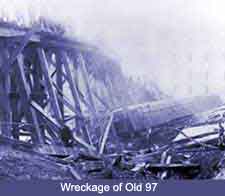 it is always best to stay on schedule, when a schedule is an important part of your job. The second is that there are far worse things than being late.
it is always best to stay on schedule, when a schedule is an important part of your job. The second is that there are far worse things than being late.
By the time Old 97 reached the Stillhouse Trestle near Danville, Virginia, Broady realized, with a horrible sense of dread and impending doom, that he did not have enough air pressure to slow the train for Stillhouse’s upcoming curved trestle. He tried, in vain to slow the train down by reversing the engine to lock the wheels, but Old 97 vaulted off the trestle, and 11 people were killed. Nine men of the eleven who died, were killed instantly. Seven men were injured. Among the deceased were the engineer Broady, conductor Blair, and flagman Moody. The bodies of both firemen were recovered, but they were mangled so badly they were unrecognizable. There were several survivors to the wreck who believed they survived because they jumped from the train just before the fatal plunge. Among the three survivors was an individual named J Harris Thompson of Lexington. Harris was a mail-clerk who served on the Southern Railroad. He later retired on May 1, 1941. W R Pinckney, the express messenger who also survived went home, located in Charlotte, North Carolina, and immediately resigned after the experience. Two other survivors included Jennings J Dunlap, and M C Maupin. These two men did not resign and continued their work, but started in new departments. Dunlap went to work on a train that ran between Washington and Charlotte, while Maupin worked at the Charlotte union station. The horrible pictures of the aftermath of the crash taken from above the scene ran in newspapers across the country.
At Monroe, Broady was instructed to get the Fast Mail to Spencer, 166 miles away…on time. The scheduled running time from Monroe to Spencer was four hours and fifteen minutes at an average speed of approximately 39 miles per hour. In order to make up the one hour delay, the train’s average speed would have to be at least 51 miles per hour. Broady was ordered to maintain speed through Franklin Junction, an intermediate stop normally made during the run. This was a time when train wrecks were not uncommon, but the day after the wreck, Southern Railway’s Vice President stated that “The train consisted of two postal cars, one express and one baggage car for the storage of mail… Eyewitnesses said the train was approaching the trestle at speeds of 30 to 35 miles an hour.” The Southern Railway placed blame for the wreck on engineer Broady, denying that he 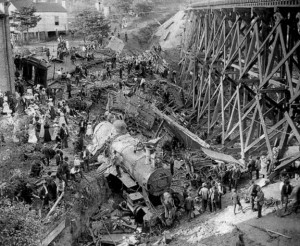 had been ordered to run as fast as possible to maintain the schedule. The railroad also claimed he descended the grade leading to Stillhouse Trestle at a speed of more than 70 miles per hour. Several eyewitnesses to the wreck, however, stated that the speed was probably around 50 miles per hour. In all likelihood, the railroad was at least partially to blame, as they had a lucrative contract with the US Post Office to haul mail…a contract that did include a penalty clause for each minute the train was late into Spencer. It is probably safe to conclude that the engineers piloting the Fast Mail were always under pressure to stay on time so the railroad would not be penalized for late mail delivery. And being under pressure can be deadly.
had been ordered to run as fast as possible to maintain the schedule. The railroad also claimed he descended the grade leading to Stillhouse Trestle at a speed of more than 70 miles per hour. Several eyewitnesses to the wreck, however, stated that the speed was probably around 50 miles per hour. In all likelihood, the railroad was at least partially to blame, as they had a lucrative contract with the US Post Office to haul mail…a contract that did include a penalty clause for each minute the train was late into Spencer. It is probably safe to conclude that the engineers piloting the Fast Mail were always under pressure to stay on time so the railroad would not be penalized for late mail delivery. And being under pressure can be deadly.

 On August 13, 1961, in the hours just after midnight, the East German soldiers began laying down barbed wire and bricks as a barrier between Soviet-controlled East Berlin and the democratic western section of the city. It was a day that would change life in Berlin for the next twenty eight years. In the days that followed, a wall was built to permanently close off access to the west. The citizens of East Berlin became prisoners in their own homes and city, in a prison that was built around them. The road between East and West Berlin had become a one way street. If you wanted in, you couldn’t come back out. Families were separated from each other, and those in the West had to make the choice to go be with family in East Berlin…and captivity, or not. The wall became the symbol of the Cold War. It was a literal Iron Curtain, dividing Europe.
On August 13, 1961, in the hours just after midnight, the East German soldiers began laying down barbed wire and bricks as a barrier between Soviet-controlled East Berlin and the democratic western section of the city. It was a day that would change life in Berlin for the next twenty eight years. In the days that followed, a wall was built to permanently close off access to the west. The citizens of East Berlin became prisoners in their own homes and city, in a prison that was built around them. The road between East and West Berlin had become a one way street. If you wanted in, you couldn’t come back out. Families were separated from each other, and those in the West had to make the choice to go be with family in East Berlin…and captivity, or not. The wall became the symbol of the Cold War. It was a literal Iron Curtain, dividing Europe.
When World War II ended in 1945, Germany was divided into four Allied occupation zones. Berlin, the German capital, was likewise divided into occupation sectors, even though it was located deep within the Soviet occupation zone. The future of Germany was a source of contention. Disagreements brought tensions which grew when the United States, Britain, and France moved in 1948 to unite their occupation zones into a single autonomous entity known as the Federal Republic of Germany or West Germany. In response, the Soviet Union launched a land blockage of West Berlin in an effort to force the West to abandon the city. The United States and Britain responded with a massive airlift of food and supplies to West Berlin, and in May of 1949, the Soviet Union ended the blockade in defeat.
That didn’t remove the tensions that plagued the area, however. By 1961 the Cold War tensions were running high again. The East German people became very dissatisfied with life under the communist system. West Berlin was a gateway to the West and Democracy. Between 1949 and 1961, about 2.5 million East Germans fled East Berlin to West Germany. By August of 1961, East Germans were crossing into West Germany at a rate of 2,000 people per day. Many of the refugees were skilled laborers, professionals, and intellectuals, and their loss was having a devastating effect on the East German economy. The Soviets had to figure out a way to stop the exodus, and its devastating effect on the economy. Soviet leader Nikita Khruschev made the decision to close off access from East Berlin to West Berlin.
Then came the night of August 13, 1961. The citizens of East Berlin could no longer freely pass into West Berlin. The West was taken by surprise, and threatened a trade embargo against East Germany as a retaliatory measure. The Soviets responded that such a measure would bring new blockades. The West did nothing, and the East German authorities grew more and more bold. They began closing of more and more checkpoints between East and West Berlin. On August 15, they began replacing barbed wire with concrete. The wall was supposedly designed protect their citizens from the influence of decadent capitalist culture. In realty, it protected the East German authorities from scrutiny as they did what they wanted with out retaliation.
Once it was up, the only way for East Berliners to escape the oppression of their government was to take their chances to get across in whatever way they could dream up. People attempted escape by train, tight rope, zip lines, hot air balloons, through old tunnels, impersonating soldiers, a stolen tank, and swimming. Many of these attempts ended in death for the person attempting escape. It didn’t stop them. They were so determined to live freely. About 5,000 East Germans managed to escape across the Berlin Wall to the West, but the frequency of successful escapes dwindled as the wall was increasingly fortified. Thousands of East Germans were captured during attempted crossings and 191 were killed.
On June 12, 1987 President Reagan made his great “tear down this wall” speech, but the wall remained until 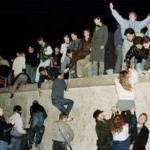
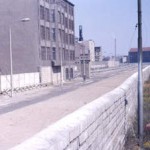 1989, when the democratization movement began sweeping across Eastern Europe. On November 9, 1989 travel restrictions were eased. Jubilant Berliners climbed on top of the Berlin Wall, painted graffiti on it, and removed fragments as souvenirs. The next day, East German troops began dismantling the wall. In 1990, East and West Germany were formally reunited. For those in the free world, it would be almost impossible to completely understand just what Communism was like, but those who lived it, would never forget it, if they even lived through it, which many didn’t.
1989, when the democratization movement began sweeping across Eastern Europe. On November 9, 1989 travel restrictions were eased. Jubilant Berliners climbed on top of the Berlin Wall, painted graffiti on it, and removed fragments as souvenirs. The next day, East German troops began dismantling the wall. In 1990, East and West Germany were formally reunited. For those in the free world, it would be almost impossible to completely understand just what Communism was like, but those who lived it, would never forget it, if they even lived through it, which many didn’t.
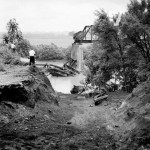 With all the rain we have been receiving, our area, along with many others have received multiple flash flood warnings, as well as flooding in many areas. When river water crosses a road, we are told not to drive through the flood, because it can take your car and cause your death. So many warnings are given to us in a flood situation. So much has been learned over the years about how to stay safe. So much has been learned about early warnings. So a lot of preparation is put in place, and yet, sometimes it’s just not enough. Such was the case on June 19, 1938.
With all the rain we have been receiving, our area, along with many others have received multiple flash flood warnings, as well as flooding in many areas. When river water crosses a road, we are told not to drive through the flood, because it can take your car and cause your death. So many warnings are given to us in a flood situation. So much has been learned over the years about how to stay safe. So much has been learned about early warnings. So a lot of preparation is put in place, and yet, sometimes it’s just not enough. Such was the case on June 19, 1938.
At that time, they didn’t have pickups that drove the rail system to check the tracks for problems. Instead a track walker was sent out to areas where there was a possible problem. Custer Creek is a small winding river that runs through 25 miles of the Great Plains on its way to the Yellowstone River. Minor streams like Custer Creek are prone to flash floods because their small capacity can quickly and easily be exceeded during heavy rains. A track walker was sent out to make sure everything was ok on the trestle at Custer Creek in Terry, Montana, and he reported that all was well there. Just a few hours later, a sudden downpour came through the area. The rising water in Custer Creek washed out the bridge and when the Olympian Special came through, it went crashing into the raging waters with no warning at all.
Two sleeper cars were immediately buried in the muddy waters, and the moonless night extremely hampered rescue efforts. In the end, 46 people lost their lives. The rear cars stayed above the water, but many passengers were seriously injured. To make matters worse, they could not be evacuated until the following morning. To hear of a train going into river in a flood is…at the very least, rare. I’ve heard of trains derailing…we all have, but this was different. On a moonless, pitch black night, my guess is that the engineer had no idea what 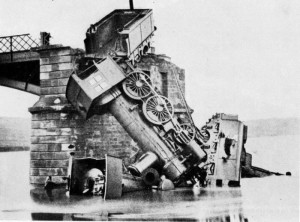 was about to happen. The shock must have been sickening to say the very least. Just knowing that people were going to die and there was nothing you could do about it, must have been the most horrible experience of an engineer’s life. Completely unimaginable.
was about to happen. The shock must have been sickening to say the very least. Just knowing that people were going to die and there was nothing you could do about it, must have been the most horrible experience of an engineer’s life. Completely unimaginable.
These days there are different safety measures in place, but that still doesn’t guarantee that such an event couldn’t happen again. I don’t know what the solution would be in these situations, but I’m sure that if there is one, technology will find a way to fix the problem. In those days, with the technology they had, they had done all they could, and yet, lives were still lost.

![10592837_10203606798789446_4580093225917977156_n[1]](https://carynschulenberg.com/wp-content/uploads/2015/05/10592837_10203606798789446_4580093225917977156_n1-150x150.jpg) Last night, while my sister, Cheryl Masterson and I were going through several boxes of our parents paperwork to prepare it for shredding, we came across a number of letters from different family members. I was drawn to some from my dad’s brother, William Spencer. One letter was written on March 5, 1990, and told a lot about the small town of Holyoke, Minnesota, where the family lived for a number of years. Uncle Bill talked of how the town was just a skeleton now, and so unlike its former self. I could read the sadness in his thoughts. Holyoke was a place that, in his childhood, had seemed larger than life. He knew every inch of it. He and my dad, their sister, Ruth, and their friends had dodged the trains, played ball, gone to school, fished the stream, and…well, lived life there. Uncle Bill was sad, because now, all that was changing.
Last night, while my sister, Cheryl Masterson and I were going through several boxes of our parents paperwork to prepare it for shredding, we came across a number of letters from different family members. I was drawn to some from my dad’s brother, William Spencer. One letter was written on March 5, 1990, and told a lot about the small town of Holyoke, Minnesota, where the family lived for a number of years. Uncle Bill talked of how the town was just a skeleton now, and so unlike its former self. I could read the sadness in his thoughts. Holyoke was a place that, in his childhood, had seemed larger than life. He knew every inch of it. He and my dad, their sister, Ruth, and their friends had dodged the trains, played ball, gone to school, fished the stream, and…well, lived life there. Uncle Bill was sad, because now, all that was changing.
Uncle Bill wrote of the passing of this friend, and that friend, as well as all the citizens, teachers, parents, and business owners who had lived in the little town of Holyoke. While the passing of the people he knew and loved was hard enough, the loss of the different buildings in the town was equally devastating to my dear Uncle Bill. I think the building that was the hardest for him to see go was the little church, which held the baptismal font that had been built in 1935 by Fritz Fredrick, who is the father of my cousins Gene and Dennis Fredrick. Fritz also did most of the cabinet work, too. It was very hard for Uncle Bill to think of that baptismal font being left to rot, so he bought it and gave it to one of Fritz’s sons. Uncle Bill writes about how sad it makes him to see the buildings delapitated and, in his words, forlorn. Nevertheless, he continues to be drawn to Holyoke because it feels like going home to him. He loves the people there, and loves to spend time visiting with them. Holyoke is and always will be a part of him…like it’s in his DNA.
Uncle Bill’s letter continues to draw me back to it in much the same way that Holyoke draws Uncle Bill back to ![10342804_10203606793869323_3232942561128602595_n[1]](https://carynschulenberg.com/wp-content/uploads/2015/05/10342804_10203606793869323_3232942561128602595_n1-150x150.jpg)
![10624963_10203606795149355_518549074166794281_n[1]](https://carynschulenberg.com/wp-content/uploads/2015/05/10624963_10203606795149355_518549074166794281_n1-150x150.jpg) it, because even if the feelings are raw and painful to a degree, it is harder not to make the trip than it is the deal with the feelings when you go back there. My mom, Collene Spencer, my sister, Cheryl Masterson, my cousin Bill Spencer (Uncle Bill’s son), and I visited Holyoke this past August while we were back in Superior, Wisconsin, and I can completely understand how Uncle Bill feels about that place. I don’t recall having been there before, but like my Uncle Bill, Holyoke, Minnesota will continue to live in my heart. I guess that some places simply have that affect on you.
it, because even if the feelings are raw and painful to a degree, it is harder not to make the trip than it is the deal with the feelings when you go back there. My mom, Collene Spencer, my sister, Cheryl Masterson, my cousin Bill Spencer (Uncle Bill’s son), and I visited Holyoke this past August while we were back in Superior, Wisconsin, and I can completely understand how Uncle Bill feels about that place. I don’t recall having been there before, but like my Uncle Bill, Holyoke, Minnesota will continue to live in my heart. I guess that some places simply have that affect on you.
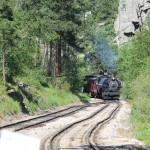 I read an article in the Casper Star Tribune yesterday that made me think about the many changes in the railroad over the years. When my grandfather, Allen Luther Spencer was working on the railroad as a carpenter during World War II, and for years before that, it took a number of people to run a train. The freight trains during World War II typically had seven people aboard…an engineer, conductor, up to four brakemen and a fireman. With all the trains that were running…not nearly as many as we have today…the railroad supplied a lot of jobs. This was just to run the actual train. The maintenance personnel, the station managers, and others who were required to keep the trains running smoothly, added to the number of people it took to ultimately move the trains along the tracks at any given moment. The trains of that era weren’t anywhere near as long as they are these days either.
I read an article in the Casper Star Tribune yesterday that made me think about the many changes in the railroad over the years. When my grandfather, Allen Luther Spencer was working on the railroad as a carpenter during World War II, and for years before that, it took a number of people to run a train. The freight trains during World War II typically had seven people aboard…an engineer, conductor, up to four brakemen and a fireman. With all the trains that were running…not nearly as many as we have today…the railroad supplied a lot of jobs. This was just to run the actual train. The maintenance personnel, the station managers, and others who were required to keep the trains running smoothly, added to the number of people it took to ultimately move the trains along the tracks at any given moment. The trains of that era weren’t anywhere near as long as they are these days either.
As technology became more sophisticated, fewer people were needed to run a train, and by the 1970s, the number of people on a freight train had dropped to five people, and by 1991, only the engineer and the 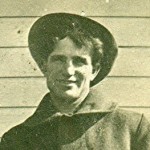 conductor were needed to run the train. When you consider that the trains have become so long that it can take twenty minutes to get the whole train through a crossing, that seems amazing to me. I guess it is amazing to a lot of other people too, because as the railroads are trying to eliminate one of those positions as well, a lot of people are quite worried about the safety of the trains. What strikes me as funny, however, is that the concern is that if they need to disconnect a car so emergency vehicles can get through, the engineer can’t leave his post to do so. I’m sure that in the future that part will be handled too, because technology is getting to the point whereby the train really could be run without a driver, just like the model trains are.
conductor were needed to run the train. When you consider that the trains have become so long that it can take twenty minutes to get the whole train through a crossing, that seems amazing to me. I guess it is amazing to a lot of other people too, because as the railroads are trying to eliminate one of those positions as well, a lot of people are quite worried about the safety of the trains. What strikes me as funny, however, is that the concern is that if they need to disconnect a car so emergency vehicles can get through, the engineer can’t leave his post to do so. I’m sure that in the future that part will be handled too, because technology is getting to the point whereby the train really could be run without a driver, just like the model trains are.
Much like the model trains, there is a controller at a central location who can see all the trains for his area. In reality, they probably could control the train with no one on it, but how strange that would be…especially when talking about passenger trains. But then, with subways, and airport trains, we often get on the train, and never see if anyone is running it. In airports, the voice telling you of your arrival is even 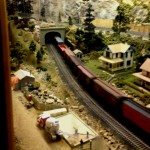 mechanical. I have to wonder if anyone is running those, and maybe someone out there will clarify that one for me. Someday, or even already, we will probably ride trains and never give a second thought to the fact that there is no engineer. Everything has become so technical, and we have reached a point of being so used to robotics, that we don’t even give a second thought to the aspect of someone being in control of this massive train we have just boarded…and people have said that flying is like being in a cattle truck. Turning control of our lives to someone we don’t know, or even to a robot, seems very strange, even today, but what would the people of my grandfather’s era have thought about having no one to run the train. I’m quite sure they would never have boarded at all.
mechanical. I have to wonder if anyone is running those, and maybe someone out there will clarify that one for me. Someday, or even already, we will probably ride trains and never give a second thought to the fact that there is no engineer. Everything has become so technical, and we have reached a point of being so used to robotics, that we don’t even give a second thought to the aspect of someone being in control of this massive train we have just boarded…and people have said that flying is like being in a cattle truck. Turning control of our lives to someone we don’t know, or even to a robot, seems very strange, even today, but what would the people of my grandfather’s era have thought about having no one to run the train. I’m quite sure they would never have boarded at all.

 When it comes to teaching babies how to do things, it seems like we all want a part in it. We may not even realize that we do, but we do. As mothers, we try many things to get our babies to eat solid foods…especially those dreaded vegetables. You might see a mother pretending that the spoon is an airplane or a train, hoping that her child will decide that food on a train or plane tastes better, or won’t notice that the dreaded vegetable has been eaten. Maybe those things work and maybe they don’t but either way, they can look very funny, and to think that as teenagers we were always thought of as pretty cool…so what happened? The thing I find really funny is that the mother always opens her mouth to apparently show the child what he needs to do. Like a kid who hates his vegetables is going to open his mouth just because his mommy did, right. I think not. Of course the funniest face in the food game is that of a child who absolutely hates the food he is getting. They look like you have just given them poison and…seriously, how could you be such a bad parent, but have you ever noticed that even a baby who hates food, happens to find her toes, she has no problem putting those in her mouth.
When it comes to teaching babies how to do things, it seems like we all want a part in it. We may not even realize that we do, but we do. As mothers, we try many things to get our babies to eat solid foods…especially those dreaded vegetables. You might see a mother pretending that the spoon is an airplane or a train, hoping that her child will decide that food on a train or plane tastes better, or won’t notice that the dreaded vegetable has been eaten. Maybe those things work and maybe they don’t but either way, they can look very funny, and to think that as teenagers we were always thought of as pretty cool…so what happened? The thing I find really funny is that the mother always opens her mouth to apparently show the child what he needs to do. Like a kid who hates his vegetables is going to open his mouth just because his mommy did, right. I think not. Of course the funniest face in the food game is that of a child who absolutely hates the food he is getting. They look like you have just given them poison and…seriously, how could you be such a bad parent, but have you ever noticed that even a baby who hates food, happens to find her toes, she has no problem putting those in her mouth.
Something women tend to do for no real reason is the open mouth to put on mascara maneuver. I really don’t know what purpose this serves, but yes, I do it too. And, I don’t know of a single woman who wears mascara that doesn’t do that. Maybe it’s an instinct, but I simply can’t understand why. It’s rarely something I think of when I am putting on my mascara, but when it is mentioned…usually by a man…I have to wonder why I do it. They say that it doesn’t make it easier to get your mascara on, but they can’t convince my mouth of that fact. It just instinctively wants to help, just like the mom who opens her mouth to get baby to eat. I don’t know, maybe there really is an eye mouth connection.
Then, of course, there is the child having his first birthday. It’s only one candle, but for some reason, not even the baby’s breath can manage to blow it out. If you want those candles to stay lit, they simply won’t, but if baby is trying to blow them out, they are like a never ending flame. Have you ever looked around at the other 
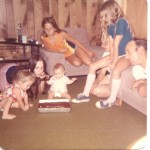 people who are watching? I’ll bet that about half of them have their mouth puckered up trying to help the baby blow out the candles. They aren’t blowing out any air, they are just puckered up…almost like they are throwing a kiss, and the baby just sits there looking at the pretty candle. I’m not even sure they really want to blow it out. Whatever the reason, you will find no such difficulty when told to eat that cake. That kid…even the one who hates everything, will dive right in, and have a totally different look on their face. But then, the look on your face might be different if you were eating cake too.
people who are watching? I’ll bet that about half of them have their mouth puckered up trying to help the baby blow out the candles. They aren’t blowing out any air, they are just puckered up…almost like they are throwing a kiss, and the baby just sits there looking at the pretty candle. I’m not even sure they really want to blow it out. Whatever the reason, you will find no such difficulty when told to eat that cake. That kid…even the one who hates everything, will dive right in, and have a totally different look on their face. But then, the look on your face might be different if you were eating cake too.

